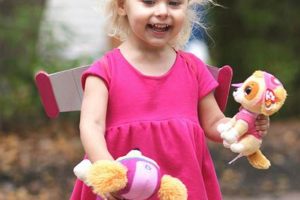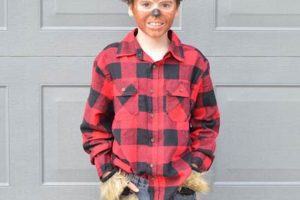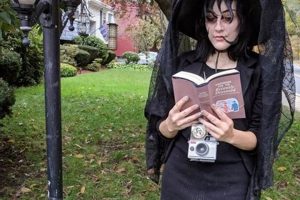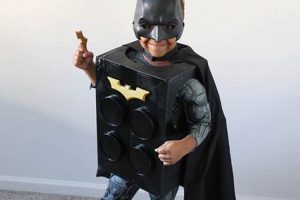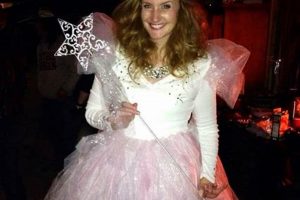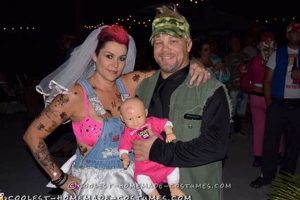A self-made Beetlejuice-inspired outfit involves creating or assembling the various elements that constitute the character’s distinctive appearance. This often includes the iconic striped suit, wild, teased hair, and ghoulish makeup. For example, one might thrift a black and white striped suit and then alter it to achieve the tattered look, or use hairspray and white powder to replicate the character’s disheveled hair.
The appeal of crafting such an outfit lies in its cost-effectiveness and the opportunity for creative expression. Rather than purchasing a pre-made costume, individuals can tailor the ensemble to their specific size, style, and budget. Historically, self-made costumes have been a popular choice, especially for events like Halloween, allowing participants to showcase ingenuity and resourcefulness.
The subsequent sections will explore specific approaches for constructing each component of a convincing and unique character recreation, encompassing makeup tutorials, suit modifications, and hair styling techniques.
Construction Tips for a Self-Made Beetlejuice Ensemble
The following suggestions aim to facilitate the creation of a successful and recognizable Beetlejuice-inspired costume. These are provided to assist individuals in replicating the character’s iconic appearance.
Tip 1: Suit Acquisition and Modification. A black and white striped suit forms the base. Thrift stores or online marketplaces often offer affordable options. Modify the suit through strategic tearing and the application of dirt or grime for a distressed aesthetic. Consider uneven hemming and the removal of buttons to enhance the chaotic appearance.
Tip 2: Makeup Application. The characters makeup is integral. A pale base should be applied liberally. Use dark eyeshadow to create sunken eyes and accentuate the cheekbones for a skeletal effect. Green or grey undertones in the makeup can further enhance the undead appearance.
Tip 3: Hair Styling. Replicating the characters wild hair requires significant volume. Teasing the hair extensively and using copious amounts of hairspray can achieve the desired height and dishevelment. White or green hairspray can add to the unkempt look.
Tip 4: Prop Incorporation. Incorporating props like a Handbook for the Recently Deceased or a sandworm replica can significantly enhance the costume’s authenticity. These props can be self-made from cardboard, fabric, or found objects.
Tip 5: Attention to Detail. The character’s look involves more than just suit and make up. Yellowed or discolored teeth achieved through temporary tooth paint and the character’s distinct mannerisms can elevate the overall impact.
Tip 6: Achieving the Grimy Aesthetic. To achieve a convincing grimy aesthetic, utilize techniques such as dry brushing with dark brown or black paint, focusing on areas like the collar, cuffs, and seams of the suit. This adds depth and a sense of decay.
Tip 7: Safe Makeup Practices. Prioritize safety when applying makeup. Use non-toxic, hypoallergenic products to minimize the risk of skin irritation. Always test a small area of skin before applying makeup extensively.
By adhering to these suggestions, the construction of a compelling and recognizable Beetlejuice-inspired costume becomes more attainable. Creative repurposing and mindful execution are essential to achieve a successful result.
The next section addresses common challenges and provides solutions for creating a truly unique and memorable character interpretation.
1. Striped Suit
The black and white striped suit is arguably the most identifiable element of the Beetlejuice character, establishing a direct and causal link with any attempt at a self-created representation of the character. The suit’s presence is fundamental; its absence fundamentally alters the costume’s recognizability. For instance, substituting the striped pattern with a solid color fabric would immediately diminish the resemblance to the intended character. Real-life examples of fan-made costumes consistently demonstrate the inclusion of the striped suit, often prioritizing its accuracy in pattern and distress over other details. Thus, the striped suit serves as a visual anchor, essential for immediate character identification.
The practical significance of understanding this connection lies in resource allocation during costume creation. Individuals undertaking the project might prioritize finding or creating an acceptable striped suit above other elements. This prioritization could involve thrift store hunts, online fabric purchases, or even hand-painting stripes onto a plain suit. Effective execution often hinges on the accurate representation of the suit’s stripes, necessitating attention to stripe width, color contrast, and the overall cut of the garment. The choice of fabric can also significantly influence the finished look, with stiffer materials contributing to a more structured, and perhaps less tattered, appearance.
In summary, the striped suit is not merely a component of the do-it-yourself Beetlejuice ensemble; it is its cornerstone. Challenges in replicating the suit directly impact the costume’s overall effectiveness. Accurate reproduction, while potentially resource-intensive, is crucial. Consequently, a focused effort towards achieving a suitable representation of this key element is paramount when embarking on the project. Subsequent choices regarding makeup, hair, and accessories should complement the striped suit, reinforcing the character’s visual identity.
2. Ghoulish Makeup
Ghoulish makeup functions as a critical element in achieving a recognizable and effective self-made Beetlejuice costume. It transcends simple cosmetic application, embodying the character’s decayed and otherworldly essence. The degree to which the makeup replicates this decaying aesthetic directly correlates with the costume’s success.
- Pale Complexion
A foundation of pallid skin is fundamental. This is typically achieved through the application of white or light-grey face paint. The purpose is to eliminate natural skin tones and create a canvas that suggests death or illness. Real-world examples of successful self-made costumes demonstrate consistent application of this pale base, often extending down the neck and onto visible chest areas. Failure to accurately reproduce this paleness compromises the undead appearance and diminishes overall impact.
- Sunken Eyes
The creation of sunken eyes relies on strategic contouring with dark eyeshadow, typically black or dark brown. Applying this shadow around the eye socket gives the illusion of depth and emphasizes the character’s skeletal features. Observations of various renditions reveal that a generous, yet carefully blended, application of dark shadow contributes to the overall gaunt impression. Insufficient or
poorly applied eye makeup results in a less convincing and less impactful costume. - Decayed Skin Tone
Beyond the pale base, an effective recreation often incorporates subtle hints of green, grey, or purple to simulate decaying skin. This can be accomplished through washes of colored powder or cream makeup. The intent is not to create overtly unnatural hues, but rather to suggest a subtle discoloration indicative of decomposition. Examining professional stage makeup for similar effects illustrates the power of understated color to enhance realism. Overuse, however, can result in a cartoonish effect, detracting from the desired ghoulishness.
- Exaggerated Features
The character’s makeup frequently features exaggerated features, such as pronounced cheekbones and shadowed hollows. These augmentations reinforce the skeletal and emaciated look. This effect can be achieved through contouring techniques, highlighting the cheekbones with pale makeup and shading beneath them with dark makeup. Successful implementations subtly enhance the underlying bone structure, creating a more haunting and striking visual. Omission of such exaggerations can lead to a less dramatic and less effective portrayal.
These facets, working in concert, constitute the essential components of ghoulish makeup necessary for a compelling representation of the Beetlejuice character in a self-made costume. The careful and deliberate application of pale foundation, sunken eyes, decayed skin tones, and exaggerated features significantly enhance the costume’s effectiveness. The success of a do-it-yourself costume hinges on replicating the unsettling and unnatural appearance of the character through considered makeup techniques.
3. Wild Hair
Wild hair serves as a prominent visual cue in identifying the Beetlejuice character and is, therefore, a critical component of a convincing self-created costume. Its unkempt and voluminous nature contributes significantly to the character’s overall chaotic and unsettling aesthetic. The degree to which an individual successfully replicates this wildness directly impacts the immediate recognizability of the ensemble.
- Volume and Height
Achieving significant volume and height is fundamental to replicating the hairstyle. This typically involves teasing the hair at the roots to create lift and support. Historical examples of fan-made costumes frequently showcase attempts to maximize hair volume, often using techniques like backcombing and hair padding. The absence of substantial volume diminishes the visual impact and reduces the immediate association with the intended character.
- Texture and Disarray
The hairs texture should appear chaotic and disheveled. This can be achieved by manipulating the hair with fingers to create separation and unevenness. Some individuals employ texturizing products to enhance the unkempt appearance. Examination of professionally styled versions of the characters hair demonstrates a deliberate avoidance of smooth or sleek textures, instead favoring a rough and untamed aesthetic. A lack of texture renders the hairstyle too neat and undermines the character’s wild nature.
- Coloration and Product Use
The hair often features a green or grey tinge, simulating decay or unnatural coloration. This effect can be achieved through the use of temporary hairsprays or colored powders. The application should be uneven and subtly distributed to avoid an overly artificial look. Observations of successful do-it-yourself costumes reveal strategic use of coloration to enhance the ghoulish impression. Overuse of vibrant colors, however, can detract from the desired effect, making the hairstyle appear more playful than macabre.
- Hair Placement and Framing
The hairstyle should frame the face in a manner that accentuates the ghoulish makeup. Strands of hair should fall haphazardly, partially obscuring the face and contributing to an overall sense of disarray. This placement is crucial for creating a visual synergy between the hair and the makeup. Ineffectual hair placement can detract from the impact of the makeup, reducing the overall effectiveness of the costume.
Collectively, these elements volume, texture, coloration, and framing contribute to the wild nature of the character’s hairstyle. In the context of a self-made costume, attention to these details can substantially enhance the recognizability and effectiveness of the overall presentation. The replication of the wild hair complements other aspects of the costume, amplifying the character’s distinct visual presence.
4. Character Mannerisms
Character mannerisms, encompassing vocal inflections, gestures, and gait, are integral to a convincing do-it-yourself Beetlejuice costume. While visual elements like the striped suit and ghoulish makeup contribute significantly, the adoption of the character’s distinct behavior elevates the representation beyond mere imitation, forging a more immersive and recognizable portrayal.
- Vocal Inflections and Cadence
The character’s voice is characterized by a raspy quality and a rapid, often manic, delivery. Emulating this vocal style involves manipulating pitch, pace, and intonation to mirror the character’s erratic speech patterns. Examples of successful interpretations demonstrate a clear understanding of the character’s vocal delivery, incorporating pauses, stutters, and exaggerated emphasis on certain words. A failure to capture these nuances results in a less compelling impersonation, diminishing the overall impact of the costume.
- Gestural Repertoire
The character’s physical movements are typically exaggerated and theatrical, featuring wide arm gestures, jerky body movements, and frequent facial contortions. Replicating these gestures requires a deliberate and conscious effort to embody the character’s energetic and often unpredictable behavior. Examinations of various portrayals reveal that the successful adoption of these physical mannerisms enhances the characters inherent chaos. Stiff or restrained movements, conversely, undermine the desired effect.
- Facial Expressions and Grimaces
The characters face is highly expressive, shifting rapidly between expressions of glee, anger, and disgust. Mastering these facial expressions involves studying the characters onscreen performances and practicing the manipulation of facial muscles to replicate the distinct grimaces and exaggerated features. Effective mimicry enhances the costumes visual impact, adding another layer of authenticity to the portrayal. A lack of expressive facial movements results in a more static and less dynamic representation.
- Prop Integration and Physical Interaction
The character interacts with props in a specific manner. Examples include the Handbook for the Recently Deceased. How the character holds, uses or disregards this prop is important. Impersonators can use these interactions to further the costume. Does the character hold the book carefully? Does the character toss it away haphazardly? Either action amplifies the costume
In summary, character mannerisms constitute a vital, albeit often overlooked, aspect of a successful do-it-yourself Beetlejuice costume. By actively incorporating vocal inflections, gestural
repertoire, and facial expressions, individuals can elevate their representation beyond a mere visual imitation, creating a more immersive and memorable character portrayal. The absence of these nuances can significantly diminish the overall effectiveness, irrespective of the costumes visual accuracy.
5. Prop Selection
Prop selection serves as a crucial element in the construction of a convincing and recognizable do-it-yourself Beetlejuice costume. The inclusion of specific props can significantly enhance the visual narrative, adding depth and context to the overall representation. The deliberate choice of objects associated with the character directly contributes to the audience’s immediate recognition and understanding of the intended portrayal. For example, the presence of a “Handbook for the Recently Deceased” instantly signals the character’s connection to the afterlife and the film’s central narrative. The absence of such props necessitates a greater reliance on other elements, such as makeup and attire, to convey the intended identity.
The practical significance of this understanding lies in the ability to elevate a basic costume into a more nuanced and engaging representation. Individuals crafting self-made costumes can strategically incorporate props to compensate for potential limitations in other areas, such as the accuracy of the suit or the intricacy of the makeup. A well-chosen prop can act as a visual shortcut, immediately communicating key aspects of the character’s identity and backstory. Furthermore, the inclusion of props offers opportunities for interactive engagement, allowing the wearer to adopt specific poses or actions associated with the character, further enhancing the overall performance. For instance, referencing pages within the handbook adds character to the impersonator.
In summary, prop selection is not merely an optional addition but rather an integral component of a complete and compelling do-it-yourself Beetlejuice costume. The strategic incorporation of relevant objects significantly enhances the visual narrative, increasing the character’s recognizability and providing opportunities for interactive engagement. By carefully considering the props to be included, individuals can create a more immersive and memorable representation of the iconic character.
6. Cost-Effectiveness
Cost-effectiveness is a primary driver for the adoption of a self-created interpretation of the Beetlejuice character. Pre-made costumes, particularly those of high quality and accuracy, can represent a significant financial investment. Constructing the ensemble independently mitigates this expense, enabling individuals to exercise budgetary control and potentially allocate resources to specific aspects of the costume, such as higher-quality makeup or more accurate prop reproductions. The causal relationship is direct: the desire to minimize expenditure precipitates the decision to pursue a do-it-yourself approach.
The importance of cost-effectiveness extends beyond mere financial savings. It also fosters creativity and resourcefulness. Individuals may repurpose existing clothing items, utilize readily available materials, and employ innovative techniques to achieve the desired aesthetic. For instance, a basic black and white striped suit can be sourced from a thrift store for a fraction of the cost of a professionally manufactured costume. Similarly, makeup can be acquired from discount retailers or even created using household ingredients. The practical application of this principle is evident in the multitude of online tutorials and guides that provide instructions for creating specific elements of the costume using inexpensive and readily available materials.
In conclusion, cost-effectiveness is not merely a peripheral consideration but a central tenet of the do-it-yourself Beetlejuice costume. It enables individuals to engage in creative expression while adhering to budgetary constraints. The emphasis on resourcefulness and repurposing promotes sustainability and encourages the development of innovative solutions. While challenges may arise in replicating the intricate details of the character’s appearance with limited resources, the overall benefits of cost-effectiveness outweigh these challenges, making it a compelling rationale for pursuing a self-made approach.
Frequently Asked Questions
The following addresses common inquiries and concerns regarding the creation of a self-made Beetlejuice-inspired costume.
Question 1: How can a convincing striped suit be obtained without significant expense?
Thrift stores and online marketplaces often offer affordable options. Alternatively, plain black pants and a jacket can be altered by painting or sewing on white stripes.
Question 2: What makeup products are essential for replicating the character’s ghoulish appearance?
White or pale foundation, black or dark brown eyeshadow, and contouring makeup are fundamental. Green or grey undertones can further enhance the undead effect.
Question 3: How can the iconic “wild hair” be achieved, particularly for individuals with shorter hair?
Extensive teasing, backcombing, and the use of hairspray are essential. Wigs or hair extensions can be employed to add volume and length. Temporary hair color sprays can achieve the desired green or grey tint.
Question 4: What are some affordable options for creating the “Handbook for the Recently Deceased” prop?
A blank notebook or journal can be modified with a printed cover and hand-drawn illustrations. Craft foam and cardboard can be used to create a more substantial and durable prop.
Question 5: How can character mannerisms be effectively incorporated into the costume portrayal?
Careful observation of the characters speech patterns, gestures, and facial expressions is crucial. Practice and rehearsal can aid in replicating these mannerisms convincingly.
Question 6: Are there safety precautions to consider when applying makeup for the costume?
Non-toxic, hypoallergenic makeup products should be used to minimize the risk of skin irritation. A patch test is recommended before applying makeup extensively. Avoid applying makeup near the eyes.
In summary, the construction of a successful do-it-yourself Beetlejuice costume necessitates attention to detail, resourcefulness, and a willingness to experiment. Prioritizing safety and budgetary considerations is paramount.
The subsequent section will explore advanced techniques for creating a truly unique and memorable character interpretation.
diy beetlejuice costume
This exploration has detailed the creation of a “diy beetlejuice costume,” encompassing the core elements of striped suit replication, ghoulish makeup application, wild hair styling, character mannerism imitation, strategic prop selection, and cost-effective construction. These components, when executed thoughtfully, converge to form a recognizable and impactful representation of the iconic character.
The pursuit of a self-made interpretation demands commitment to detail and a creative approach to resource management. Ultimately, a successful “diy beetlejuice costume” serves not only as a testament to individual ingenuity but also as a reaffirmation of the character’s enduring cultural relevance. Individuals are encouraged to ap
proach the project with diligence and imagination, ensuring a result that honors the source material while reflecting their unique vision.


